Critical Literature Review: Leadership Theories, Styles & Behaviors
VerifiedAdded on 2023/04/25
|14
|4455
|386
Literature Review
AI Summary
This assignment presents a critical literature review of leadership, examining key issues, debates, research, and theories highlighted in selected journal articles published between 2014 and 2019. The review covers aspects such as leadership theory, gender leadership, and different leadership styles including transformational, transactional, and laissez-faire approaches. It analyzes how traits of political leaders influence voters, the role of attitude theory in understanding leadership effectiveness, and how leadership theories apply to different generations. The review also addresses gender disparities in leadership roles, exploring the challenges women face in ascending to leadership positions and the impact of gender discrimination. The analysis compares and contrasts the content of the selected articles, identifying different perspectives and arguments while evaluating their contributions and the suitability of their research and sources. Desklib provides access to this document and other study resources for students.
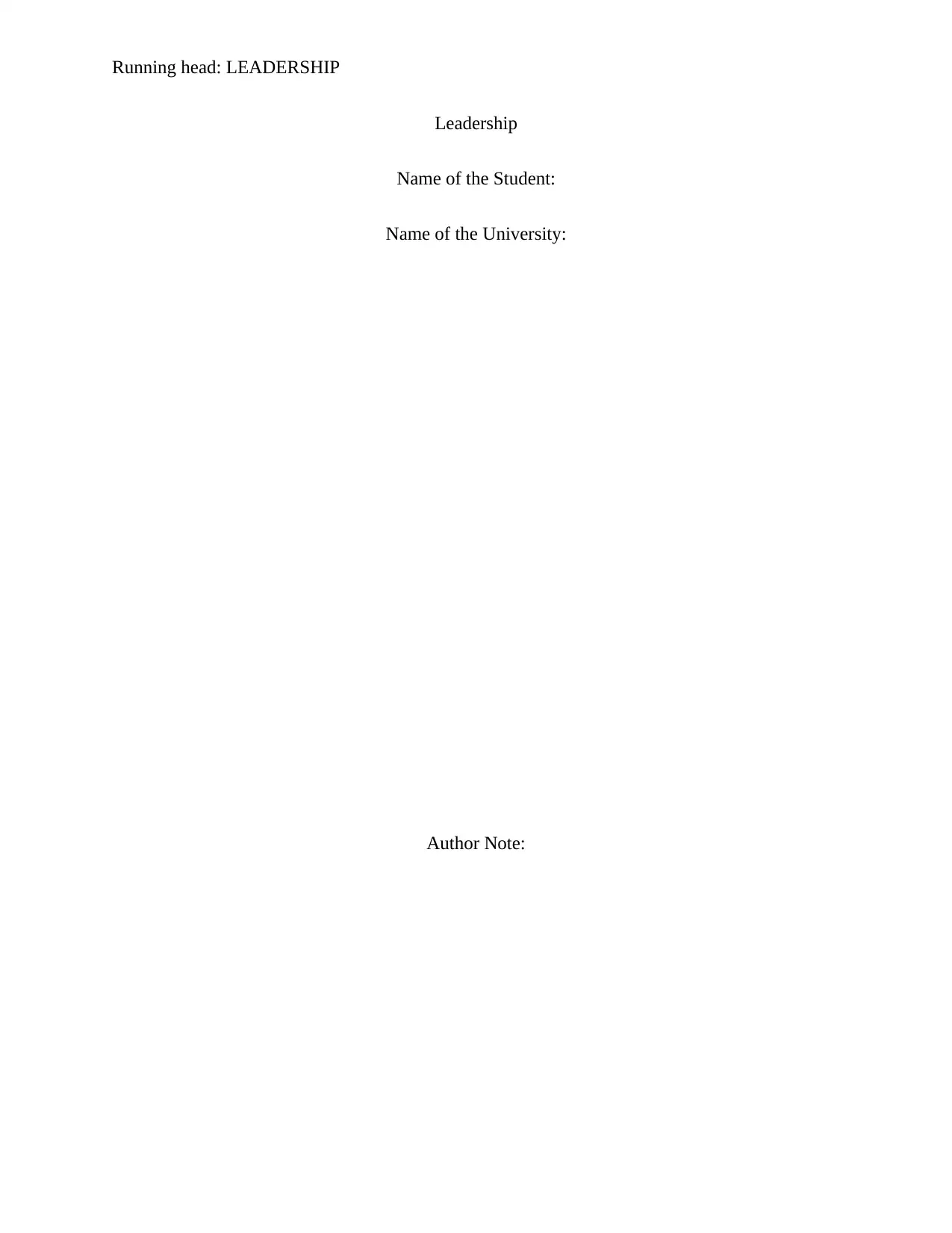
Running head: LEADERSHIP
Leadership
Name of the Student:
Name of the University:
Author Note:
Leadership
Name of the Student:
Name of the University:
Author Note:
Paraphrase This Document
Need a fresh take? Get an instant paraphrase of this document with our AI Paraphraser
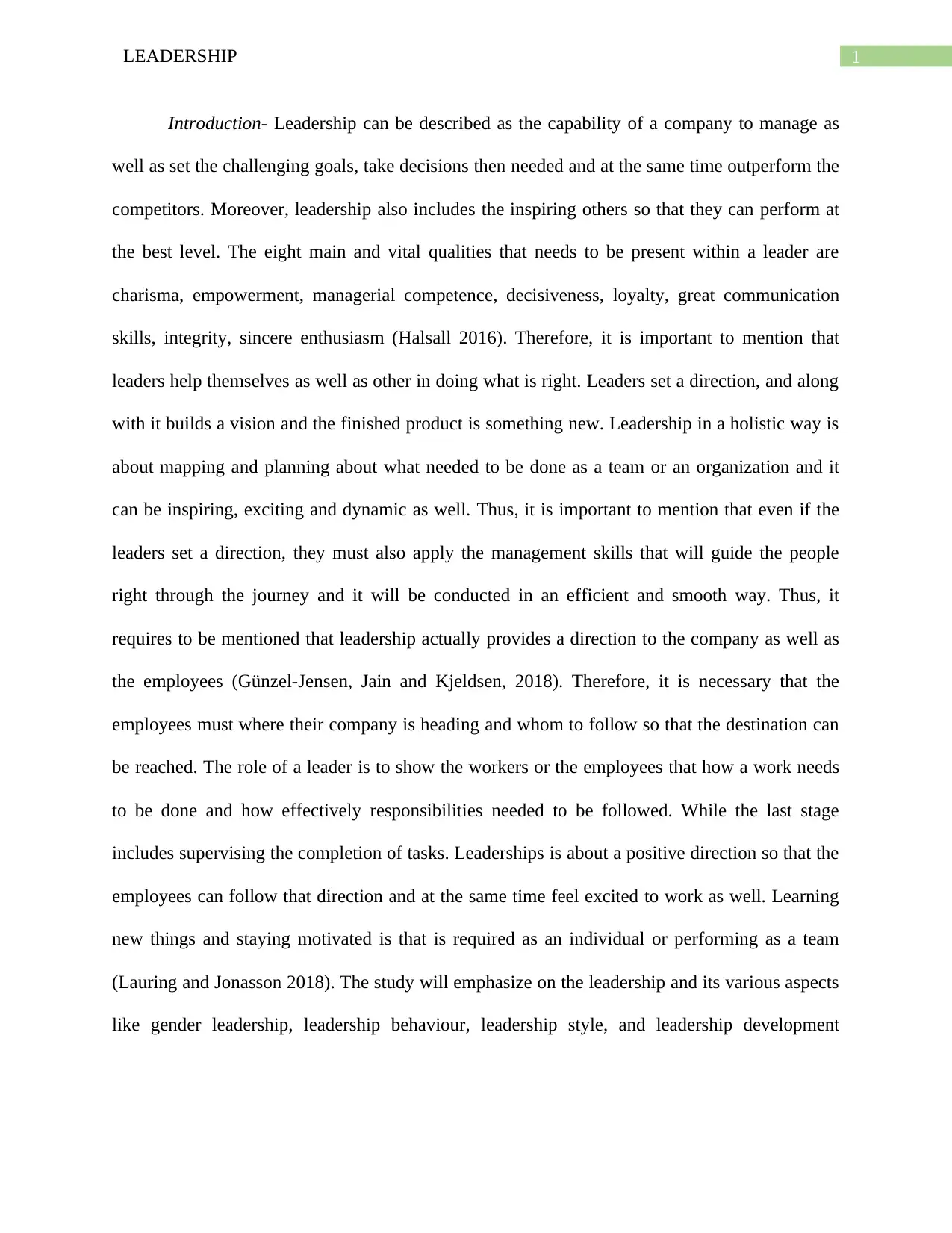
1LEADERSHIP
Introduction- Leadership can be described as the capability of a company to manage as
well as set the challenging goals, take decisions then needed and at the same time outperform the
competitors. Moreover, leadership also includes the inspiring others so that they can perform at
the best level. The eight main and vital qualities that needs to be present within a leader are
charisma, empowerment, managerial competence, decisiveness, loyalty, great communication
skills, integrity, sincere enthusiasm (Halsall 2016). Therefore, it is important to mention that
leaders help themselves as well as other in doing what is right. Leaders set a direction, and along
with it builds a vision and the finished product is something new. Leadership in a holistic way is
about mapping and planning about what needed to be done as a team or an organization and it
can be inspiring, exciting and dynamic as well. Thus, it is important to mention that even if the
leaders set a direction, they must also apply the management skills that will guide the people
right through the journey and it will be conducted in an efficient and smooth way. Thus, it
requires to be mentioned that leadership actually provides a direction to the company as well as
the employees (Günzel-Jensen, Jain and Kjeldsen, 2018). Therefore, it is necessary that the
employees must where their company is heading and whom to follow so that the destination can
be reached. The role of a leader is to show the workers or the employees that how a work needs
to be done and how effectively responsibilities needed to be followed. While the last stage
includes supervising the completion of tasks. Leaderships is about a positive direction so that the
employees can follow that direction and at the same time feel excited to work as well. Learning
new things and staying motivated is that is required as an individual or performing as a team
(Lauring and Jonasson 2018). The study will emphasize on the leadership and its various aspects
like gender leadership, leadership behaviour, leadership style, and leadership development
Introduction- Leadership can be described as the capability of a company to manage as
well as set the challenging goals, take decisions then needed and at the same time outperform the
competitors. Moreover, leadership also includes the inspiring others so that they can perform at
the best level. The eight main and vital qualities that needs to be present within a leader are
charisma, empowerment, managerial competence, decisiveness, loyalty, great communication
skills, integrity, sincere enthusiasm (Halsall 2016). Therefore, it is important to mention that
leaders help themselves as well as other in doing what is right. Leaders set a direction, and along
with it builds a vision and the finished product is something new. Leadership in a holistic way is
about mapping and planning about what needed to be done as a team or an organization and it
can be inspiring, exciting and dynamic as well. Thus, it is important to mention that even if the
leaders set a direction, they must also apply the management skills that will guide the people
right through the journey and it will be conducted in an efficient and smooth way. Thus, it
requires to be mentioned that leadership actually provides a direction to the company as well as
the employees (Günzel-Jensen, Jain and Kjeldsen, 2018). Therefore, it is necessary that the
employees must where their company is heading and whom to follow so that the destination can
be reached. The role of a leader is to show the workers or the employees that how a work needs
to be done and how effectively responsibilities needed to be followed. While the last stage
includes supervising the completion of tasks. Leaderships is about a positive direction so that the
employees can follow that direction and at the same time feel excited to work as well. Learning
new things and staying motivated is that is required as an individual or performing as a team
(Lauring and Jonasson 2018). The study will emphasize on the leadership and its various aspects
like gender leadership, leadership behaviour, leadership style, and leadership development
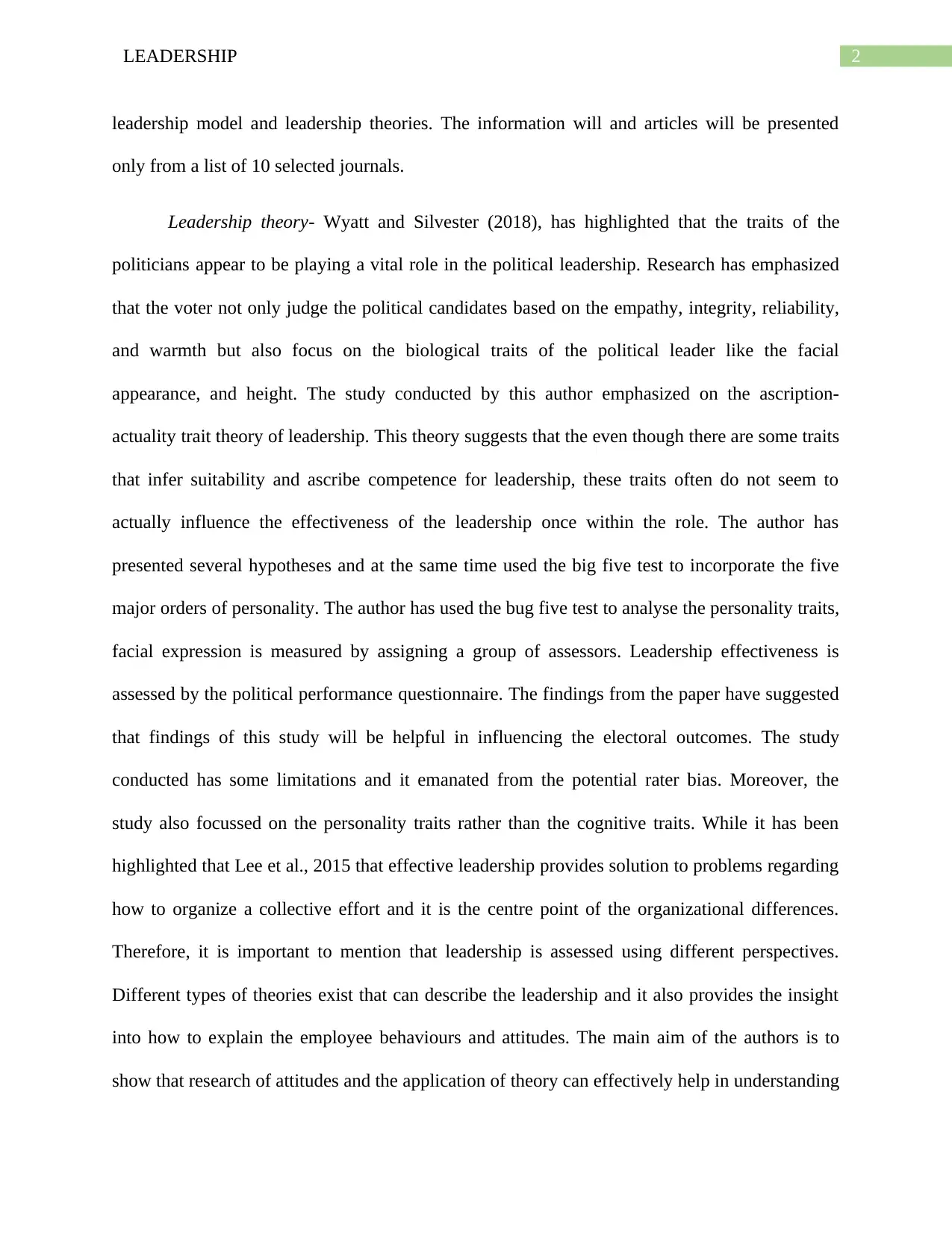
2LEADERSHIP
leadership model and leadership theories. The information will and articles will be presented
only from a list of 10 selected journals.
Leadership theory- Wyatt and Silvester (2018), has highlighted that the traits of the
politicians appear to be playing a vital role in the political leadership. Research has emphasized
that the voter not only judge the political candidates based on the empathy, integrity, reliability,
and warmth but also focus on the biological traits of the political leader like the facial
appearance, and height. The study conducted by this author emphasized on the ascription-
actuality trait theory of leadership. This theory suggests that the even though there are some traits
that infer suitability and ascribe competence for leadership, these traits often do not seem to
actually influence the effectiveness of the leadership once within the role. The author has
presented several hypotheses and at the same time used the big five test to incorporate the five
major orders of personality. The author has used the bug five test to analyse the personality traits,
facial expression is measured by assigning a group of assessors. Leadership effectiveness is
assessed by the political performance questionnaire. The findings from the paper have suggested
that findings of this study will be helpful in influencing the electoral outcomes. The study
conducted has some limitations and it emanated from the potential rater bias. Moreover, the
study also focussed on the personality traits rather than the cognitive traits. While it has been
highlighted that Lee et al., 2015 that effective leadership provides solution to problems regarding
how to organize a collective effort and it is the centre point of the organizational differences.
Therefore, it is important to mention that leadership is assessed using different perspectives.
Different types of theories exist that can describe the leadership and it also provides the insight
into how to explain the employee behaviours and attitudes. The main aim of the authors is to
show that research of attitudes and the application of theory can effectively help in understanding
leadership model and leadership theories. The information will and articles will be presented
only from a list of 10 selected journals.
Leadership theory- Wyatt and Silvester (2018), has highlighted that the traits of the
politicians appear to be playing a vital role in the political leadership. Research has emphasized
that the voter not only judge the political candidates based on the empathy, integrity, reliability,
and warmth but also focus on the biological traits of the political leader like the facial
appearance, and height. The study conducted by this author emphasized on the ascription-
actuality trait theory of leadership. This theory suggests that the even though there are some traits
that infer suitability and ascribe competence for leadership, these traits often do not seem to
actually influence the effectiveness of the leadership once within the role. The author has
presented several hypotheses and at the same time used the big five test to incorporate the five
major orders of personality. The author has used the bug five test to analyse the personality traits,
facial expression is measured by assigning a group of assessors. Leadership effectiveness is
assessed by the political performance questionnaire. The findings from the paper have suggested
that findings of this study will be helpful in influencing the electoral outcomes. The study
conducted has some limitations and it emanated from the potential rater bias. Moreover, the
study also focussed on the personality traits rather than the cognitive traits. While it has been
highlighted that Lee et al., 2015 that effective leadership provides solution to problems regarding
how to organize a collective effort and it is the centre point of the organizational differences.
Therefore, it is important to mention that leadership is assessed using different perspectives.
Different types of theories exist that can describe the leadership and it also provides the insight
into how to explain the employee behaviours and attitudes. The main aim of the authors is to
show that research of attitudes and the application of theory can effectively help in understanding
⊘ This is a preview!⊘
Do you want full access?
Subscribe today to unlock all pages.

Trusted by 1+ million students worldwide
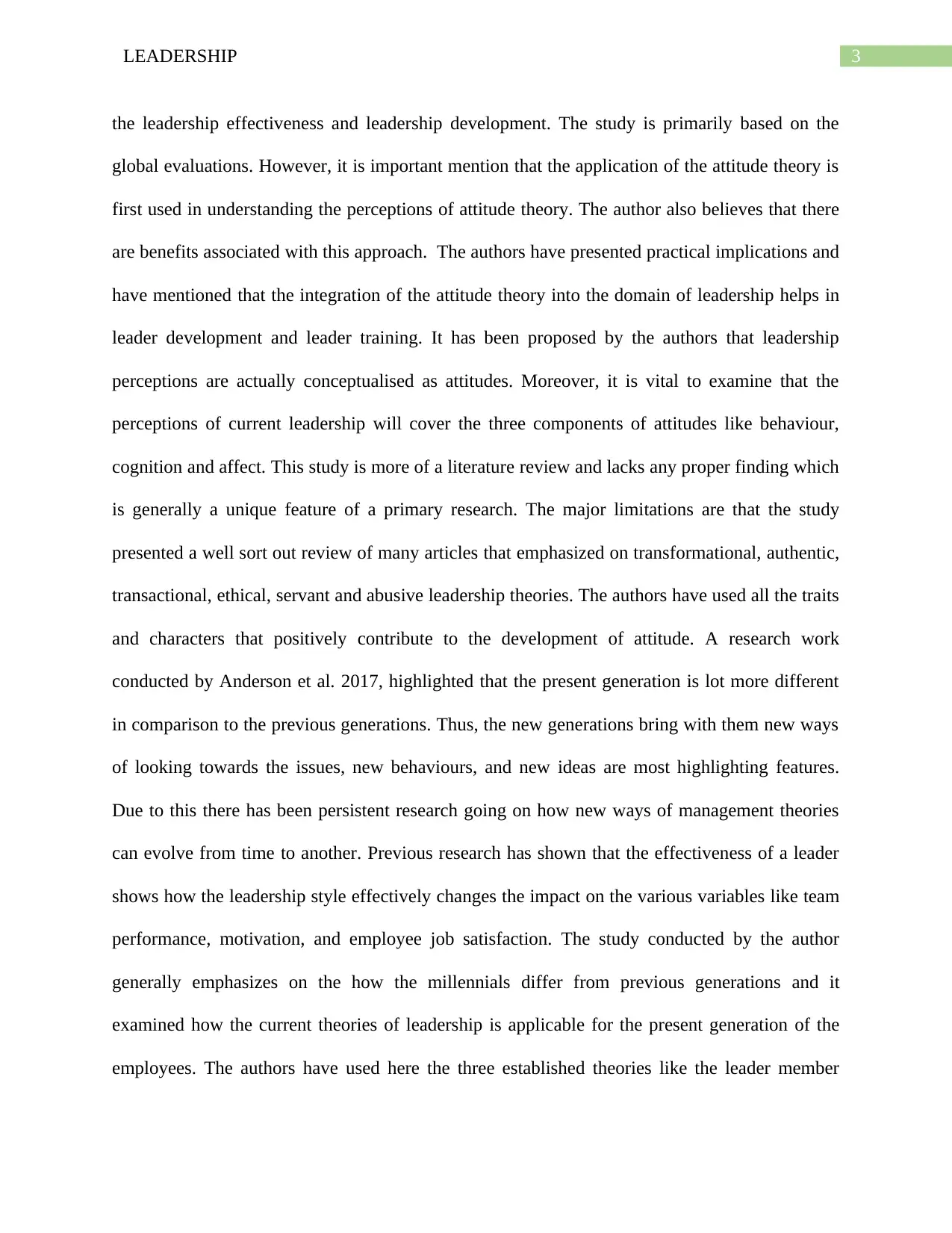
3LEADERSHIP
the leadership effectiveness and leadership development. The study is primarily based on the
global evaluations. However, it is important mention that the application of the attitude theory is
first used in understanding the perceptions of attitude theory. The author also believes that there
are benefits associated with this approach. The authors have presented practical implications and
have mentioned that the integration of the attitude theory into the domain of leadership helps in
leader development and leader training. It has been proposed by the authors that leadership
perceptions are actually conceptualised as attitudes. Moreover, it is vital to examine that the
perceptions of current leadership will cover the three components of attitudes like behaviour,
cognition and affect. This study is more of a literature review and lacks any proper finding which
is generally a unique feature of a primary research. The major limitations are that the study
presented a well sort out review of many articles that emphasized on transformational, authentic,
transactional, ethical, servant and abusive leadership theories. The authors have used all the traits
and characters that positively contribute to the development of attitude. A research work
conducted by Anderson et al. 2017, highlighted that the present generation is lot more different
in comparison to the previous generations. Thus, the new generations bring with them new ways
of looking towards the issues, new behaviours, and new ideas are most highlighting features.
Due to this there has been persistent research going on how new ways of management theories
can evolve from time to another. Previous research has shown that the effectiveness of a leader
shows how the leadership style effectively changes the impact on the various variables like team
performance, motivation, and employee job satisfaction. The study conducted by the author
generally emphasizes on the how the millennials differ from previous generations and it
examined how the current theories of leadership is applicable for the present generation of the
employees. The authors have used here the three established theories like the leader member
the leadership effectiveness and leadership development. The study is primarily based on the
global evaluations. However, it is important mention that the application of the attitude theory is
first used in understanding the perceptions of attitude theory. The author also believes that there
are benefits associated with this approach. The authors have presented practical implications and
have mentioned that the integration of the attitude theory into the domain of leadership helps in
leader development and leader training. It has been proposed by the authors that leadership
perceptions are actually conceptualised as attitudes. Moreover, it is vital to examine that the
perceptions of current leadership will cover the three components of attitudes like behaviour,
cognition and affect. This study is more of a literature review and lacks any proper finding which
is generally a unique feature of a primary research. The major limitations are that the study
presented a well sort out review of many articles that emphasized on transformational, authentic,
transactional, ethical, servant and abusive leadership theories. The authors have used all the traits
and characters that positively contribute to the development of attitude. A research work
conducted by Anderson et al. 2017, highlighted that the present generation is lot more different
in comparison to the previous generations. Thus, the new generations bring with them new ways
of looking towards the issues, new behaviours, and new ideas are most highlighting features.
Due to this there has been persistent research going on how new ways of management theories
can evolve from time to another. Previous research has shown that the effectiveness of a leader
shows how the leadership style effectively changes the impact on the various variables like team
performance, motivation, and employee job satisfaction. The study conducted by the author
generally emphasizes on the how the millennials differ from previous generations and it
examined how the current theories of leadership is applicable for the present generation of the
employees. The authors have used here the three established theories like the leader member
Paraphrase This Document
Need a fresh take? Get an instant paraphrase of this document with our AI Paraphraser

4LEADERSHIP
exchange theory, information processing and transformational leadership and two emerging
theories like the ethical leadership and authentic leadership. It has been highlighted by the
employees that the in order to lead the employees successfully the managers must be able to
utilize the abilities and needs of the employees, match the situation and the behaviour as per the
leadership style. Therefore. it is important to mention that this article has highlighted a vital point
which is not highlighted by any of the 2 articles. The current leadership theory is actually not up
to the mark and to tackle the new situation in the present generation. Thus, this particular study
sheds a new light on to the leadership theory that can effectively talk about the ethical and
authentic leadership. However, these two separate leadership theories are not provided by the
authors.
Gender leadership- It has been highlighted by Bear, J.B., Cushenbery, London and
Sherman (2017), that the path to leadership is demanding, competitive and it is shared by the
experience. While it is important to mention that the development of leadership is aided by the
elements of complexity, pressure and opportunities. While it is important to mention that the
women are less likely than men to emerge as leaders when it comes to group tasks. Moreover,
when the task involves gender roles of mixed gender types and the tasks are gendered, succeed
as a leader in the male dominated organizations and occupy a high level of leadership position.
Thus, there are many factors that contribute to the gender gap within the leadership like the
perceptions of role incongruity traditional roles of leaders and leadership, organizational
stereotyping for the women and stereotyping process. Furthermore, the path to the leadership is
considered as a labyrinth as it includes several barriers that come along the way. The path to the
leadership for a woman is largely described as the labyrinth and it presents numerous obstacles
and challenges for the women for just to navigate the leadership position. Thus, it has been
exchange theory, information processing and transformational leadership and two emerging
theories like the ethical leadership and authentic leadership. It has been highlighted by the
employees that the in order to lead the employees successfully the managers must be able to
utilize the abilities and needs of the employees, match the situation and the behaviour as per the
leadership style. Therefore. it is important to mention that this article has highlighted a vital point
which is not highlighted by any of the 2 articles. The current leadership theory is actually not up
to the mark and to tackle the new situation in the present generation. Thus, this particular study
sheds a new light on to the leadership theory that can effectively talk about the ethical and
authentic leadership. However, these two separate leadership theories are not provided by the
authors.
Gender leadership- It has been highlighted by Bear, J.B., Cushenbery, London and
Sherman (2017), that the path to leadership is demanding, competitive and it is shared by the
experience. While it is important to mention that the development of leadership is aided by the
elements of complexity, pressure and opportunities. While it is important to mention that the
women are less likely than men to emerge as leaders when it comes to group tasks. Moreover,
when the task involves gender roles of mixed gender types and the tasks are gendered, succeed
as a leader in the male dominated organizations and occupy a high level of leadership position.
Thus, there are many factors that contribute to the gender gap within the leadership like the
perceptions of role incongruity traditional roles of leaders and leadership, organizational
stereotyping for the women and stereotyping process. Furthermore, the path to the leadership is
considered as a labyrinth as it includes several barriers that come along the way. The path to the
leadership for a woman is largely described as the labyrinth and it presents numerous obstacles
and challenges for the women for just to navigate the leadership position. Thus, it has been
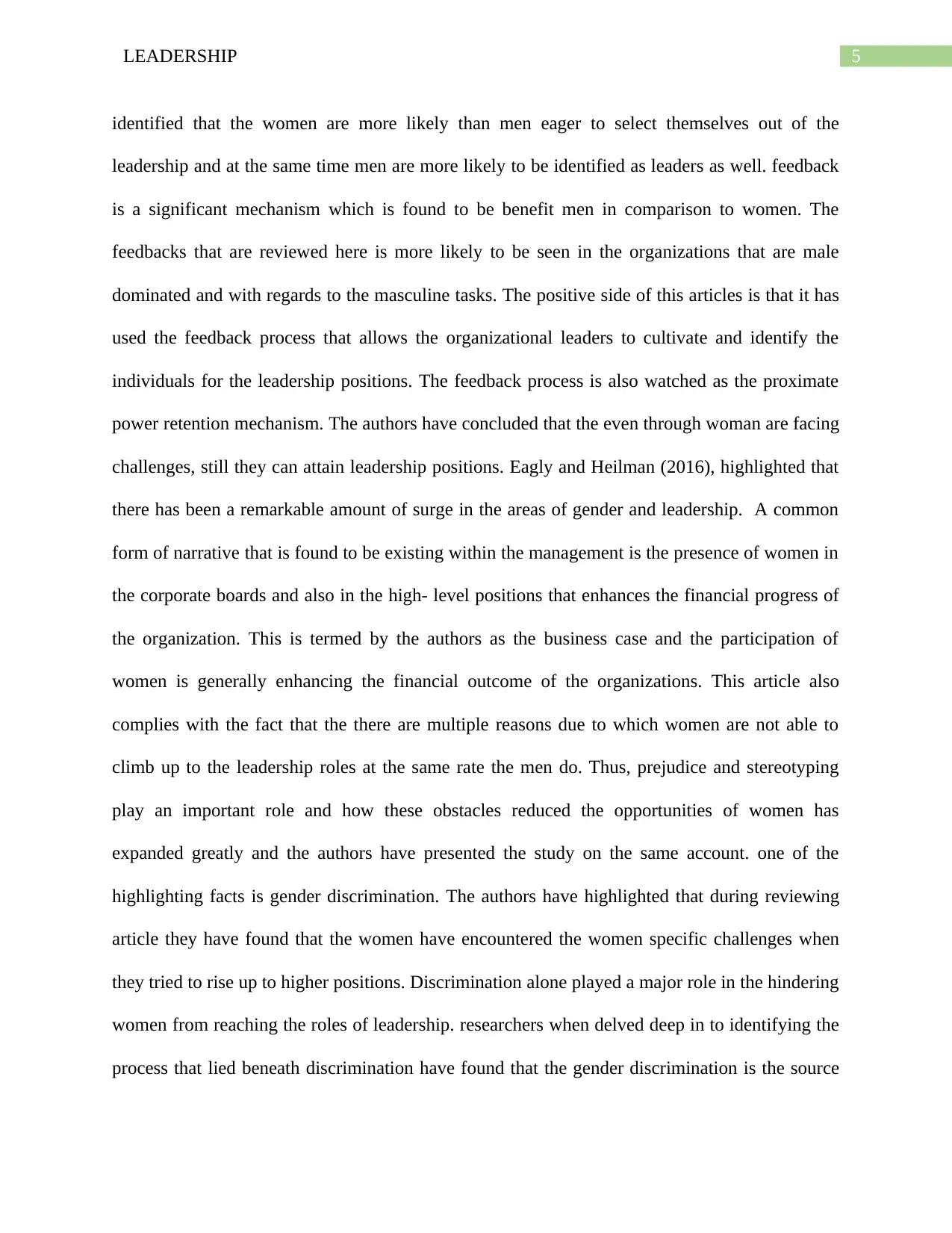
5LEADERSHIP
identified that the women are more likely than men eager to select themselves out of the
leadership and at the same time men are more likely to be identified as leaders as well. feedback
is a significant mechanism which is found to be benefit men in comparison to women. The
feedbacks that are reviewed here is more likely to be seen in the organizations that are male
dominated and with regards to the masculine tasks. The positive side of this articles is that it has
used the feedback process that allows the organizational leaders to cultivate and identify the
individuals for the leadership positions. The feedback process is also watched as the proximate
power retention mechanism. The authors have concluded that the even through woman are facing
challenges, still they can attain leadership positions. Eagly and Heilman (2016), highlighted that
there has been a remarkable amount of surge in the areas of gender and leadership. A common
form of narrative that is found to be existing within the management is the presence of women in
the corporate boards and also in the high- level positions that enhances the financial progress of
the organization. This is termed by the authors as the business case and the participation of
women is generally enhancing the financial outcome of the organizations. This article also
complies with the fact that the there are multiple reasons due to which women are not able to
climb up to the leadership roles at the same rate the men do. Thus, prejudice and stereotyping
play an important role and how these obstacles reduced the opportunities of women has
expanded greatly and the authors have presented the study on the same account. one of the
highlighting facts is gender discrimination. The authors have highlighted that during reviewing
article they have found that the women have encountered the women specific challenges when
they tried to rise up to higher positions. Discrimination alone played a major role in the hindering
women from reaching the roles of leadership. researchers when delved deep in to identifying the
process that lied beneath discrimination have found that the gender discrimination is the source
identified that the women are more likely than men eager to select themselves out of the
leadership and at the same time men are more likely to be identified as leaders as well. feedback
is a significant mechanism which is found to be benefit men in comparison to women. The
feedbacks that are reviewed here is more likely to be seen in the organizations that are male
dominated and with regards to the masculine tasks. The positive side of this articles is that it has
used the feedback process that allows the organizational leaders to cultivate and identify the
individuals for the leadership positions. The feedback process is also watched as the proximate
power retention mechanism. The authors have concluded that the even through woman are facing
challenges, still they can attain leadership positions. Eagly and Heilman (2016), highlighted that
there has been a remarkable amount of surge in the areas of gender and leadership. A common
form of narrative that is found to be existing within the management is the presence of women in
the corporate boards and also in the high- level positions that enhances the financial progress of
the organization. This is termed by the authors as the business case and the participation of
women is generally enhancing the financial outcome of the organizations. This article also
complies with the fact that the there are multiple reasons due to which women are not able to
climb up to the leadership roles at the same rate the men do. Thus, prejudice and stereotyping
play an important role and how these obstacles reduced the opportunities of women has
expanded greatly and the authors have presented the study on the same account. one of the
highlighting facts is gender discrimination. The authors have highlighted that during reviewing
article they have found that the women have encountered the women specific challenges when
they tried to rise up to higher positions. Discrimination alone played a major role in the hindering
women from reaching the roles of leadership. researchers when delved deep in to identifying the
process that lied beneath discrimination have found that the gender discrimination is the source
⊘ This is a preview!⊘
Do you want full access?
Subscribe today to unlock all pages.

Trusted by 1+ million students worldwide
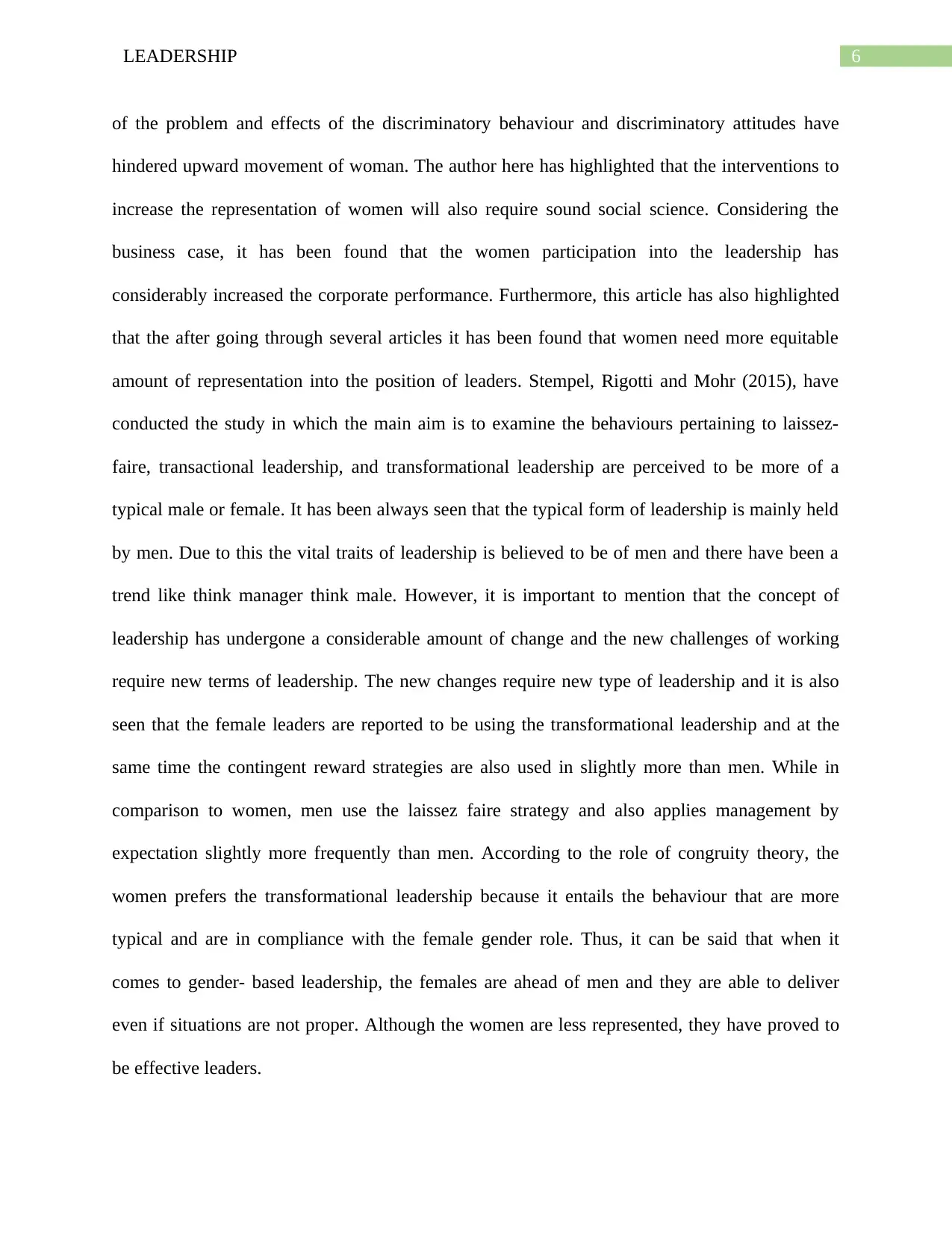
6LEADERSHIP
of the problem and effects of the discriminatory behaviour and discriminatory attitudes have
hindered upward movement of woman. The author here has highlighted that the interventions to
increase the representation of women will also require sound social science. Considering the
business case, it has been found that the women participation into the leadership has
considerably increased the corporate performance. Furthermore, this article has also highlighted
that the after going through several articles it has been found that women need more equitable
amount of representation into the position of leaders. Stempel, Rigotti and Mohr (2015), have
conducted the study in which the main aim is to examine the behaviours pertaining to laissez-
faire, transactional leadership, and transformational leadership are perceived to be more of a
typical male or female. It has been always seen that the typical form of leadership is mainly held
by men. Due to this the vital traits of leadership is believed to be of men and there have been a
trend like think manager think male. However, it is important to mention that the concept of
leadership has undergone a considerable amount of change and the new challenges of working
require new terms of leadership. The new changes require new type of leadership and it is also
seen that the female leaders are reported to be using the transformational leadership and at the
same time the contingent reward strategies are also used in slightly more than men. While in
comparison to women, men use the laissez faire strategy and also applies management by
expectation slightly more frequently than men. According to the role of congruity theory, the
women prefers the transformational leadership because it entails the behaviour that are more
typical and are in compliance with the female gender role. Thus, it can be said that when it
comes to gender- based leadership, the females are ahead of men and they are able to deliver
even if situations are not proper. Although the women are less represented, they have proved to
be effective leaders.
of the problem and effects of the discriminatory behaviour and discriminatory attitudes have
hindered upward movement of woman. The author here has highlighted that the interventions to
increase the representation of women will also require sound social science. Considering the
business case, it has been found that the women participation into the leadership has
considerably increased the corporate performance. Furthermore, this article has also highlighted
that the after going through several articles it has been found that women need more equitable
amount of representation into the position of leaders. Stempel, Rigotti and Mohr (2015), have
conducted the study in which the main aim is to examine the behaviours pertaining to laissez-
faire, transactional leadership, and transformational leadership are perceived to be more of a
typical male or female. It has been always seen that the typical form of leadership is mainly held
by men. Due to this the vital traits of leadership is believed to be of men and there have been a
trend like think manager think male. However, it is important to mention that the concept of
leadership has undergone a considerable amount of change and the new challenges of working
require new terms of leadership. The new changes require new type of leadership and it is also
seen that the female leaders are reported to be using the transformational leadership and at the
same time the contingent reward strategies are also used in slightly more than men. While in
comparison to women, men use the laissez faire strategy and also applies management by
expectation slightly more frequently than men. According to the role of congruity theory, the
women prefers the transformational leadership because it entails the behaviour that are more
typical and are in compliance with the female gender role. Thus, it can be said that when it
comes to gender- based leadership, the females are ahead of men and they are able to deliver
even if situations are not proper. Although the women are less represented, they have proved to
be effective leaders.
Paraphrase This Document
Need a fresh take? Get an instant paraphrase of this document with our AI Paraphraser
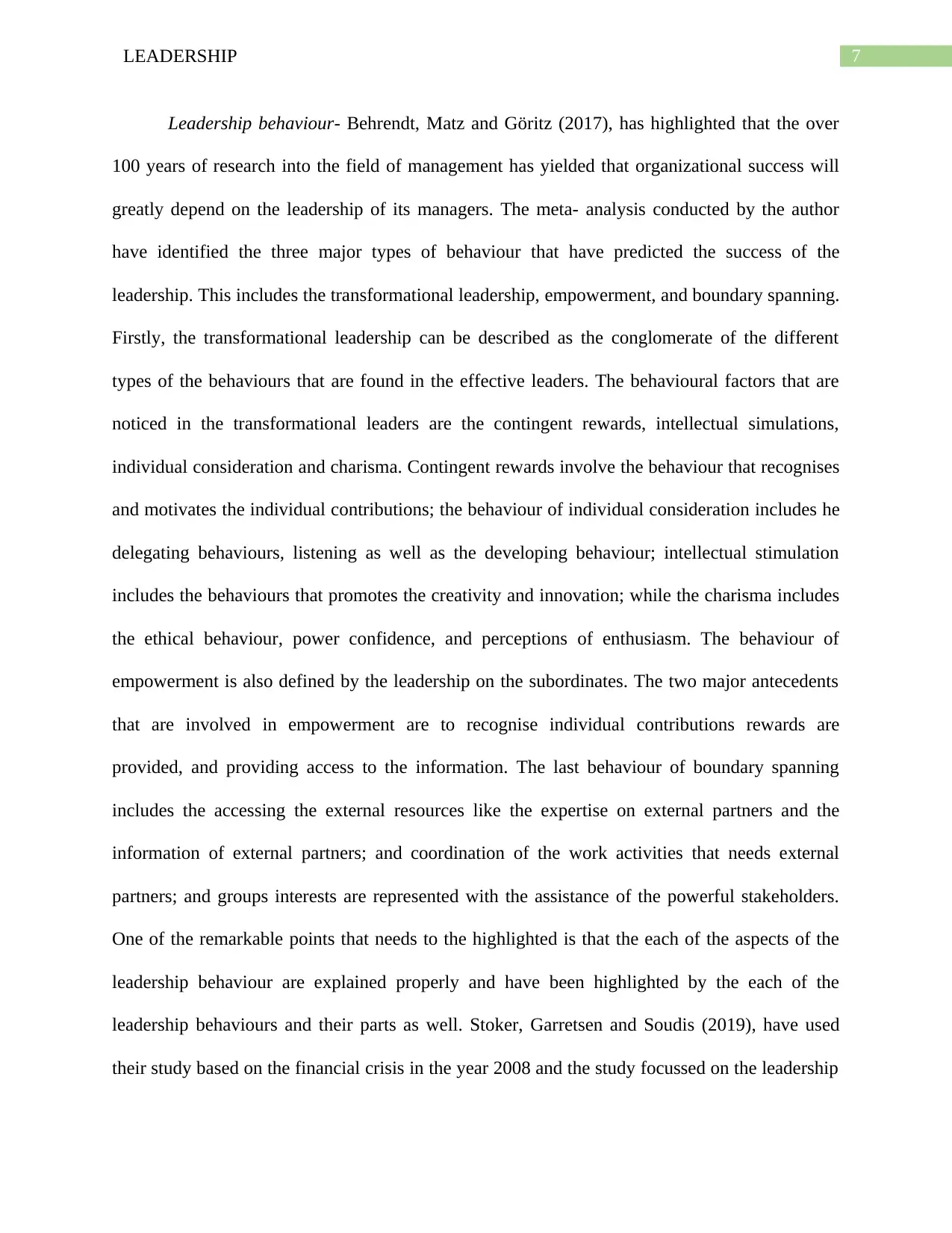
7LEADERSHIP
Leadership behaviour- Behrendt, Matz and Göritz (2017), has highlighted that the over
100 years of research into the field of management has yielded that organizational success will
greatly depend on the leadership of its managers. The meta- analysis conducted by the author
have identified the three major types of behaviour that have predicted the success of the
leadership. This includes the transformational leadership, empowerment, and boundary spanning.
Firstly, the transformational leadership can be described as the conglomerate of the different
types of the behaviours that are found in the effective leaders. The behavioural factors that are
noticed in the transformational leaders are the contingent rewards, intellectual simulations,
individual consideration and charisma. Contingent rewards involve the behaviour that recognises
and motivates the individual contributions; the behaviour of individual consideration includes he
delegating behaviours, listening as well as the developing behaviour; intellectual stimulation
includes the behaviours that promotes the creativity and innovation; while the charisma includes
the ethical behaviour, power confidence, and perceptions of enthusiasm. The behaviour of
empowerment is also defined by the leadership on the subordinates. The two major antecedents
that are involved in empowerment are to recognise individual contributions rewards are
provided, and providing access to the information. The last behaviour of boundary spanning
includes the accessing the external resources like the expertise on external partners and the
information of external partners; and coordination of the work activities that needs external
partners; and groups interests are represented with the assistance of the powerful stakeholders.
One of the remarkable points that needs to the highlighted is that the each of the aspects of the
leadership behaviour are explained properly and have been highlighted by the each of the
leadership behaviours and their parts as well. Stoker, Garretsen and Soudis (2019), have used
their study based on the financial crisis in the year 2008 and the study focussed on the leadership
Leadership behaviour- Behrendt, Matz and Göritz (2017), has highlighted that the over
100 years of research into the field of management has yielded that organizational success will
greatly depend on the leadership of its managers. The meta- analysis conducted by the author
have identified the three major types of behaviour that have predicted the success of the
leadership. This includes the transformational leadership, empowerment, and boundary spanning.
Firstly, the transformational leadership can be described as the conglomerate of the different
types of the behaviours that are found in the effective leaders. The behavioural factors that are
noticed in the transformational leaders are the contingent rewards, intellectual simulations,
individual consideration and charisma. Contingent rewards involve the behaviour that recognises
and motivates the individual contributions; the behaviour of individual consideration includes he
delegating behaviours, listening as well as the developing behaviour; intellectual stimulation
includes the behaviours that promotes the creativity and innovation; while the charisma includes
the ethical behaviour, power confidence, and perceptions of enthusiasm. The behaviour of
empowerment is also defined by the leadership on the subordinates. The two major antecedents
that are involved in empowerment are to recognise individual contributions rewards are
provided, and providing access to the information. The last behaviour of boundary spanning
includes the accessing the external resources like the expertise on external partners and the
information of external partners; and coordination of the work activities that needs external
partners; and groups interests are represented with the assistance of the powerful stakeholders.
One of the remarkable points that needs to the highlighted is that the each of the aspects of the
leadership behaviour are explained properly and have been highlighted by the each of the
leadership behaviours and their parts as well. Stoker, Garretsen and Soudis (2019), have used
their study based on the financial crisis in the year 2008 and the study focussed on the leadership
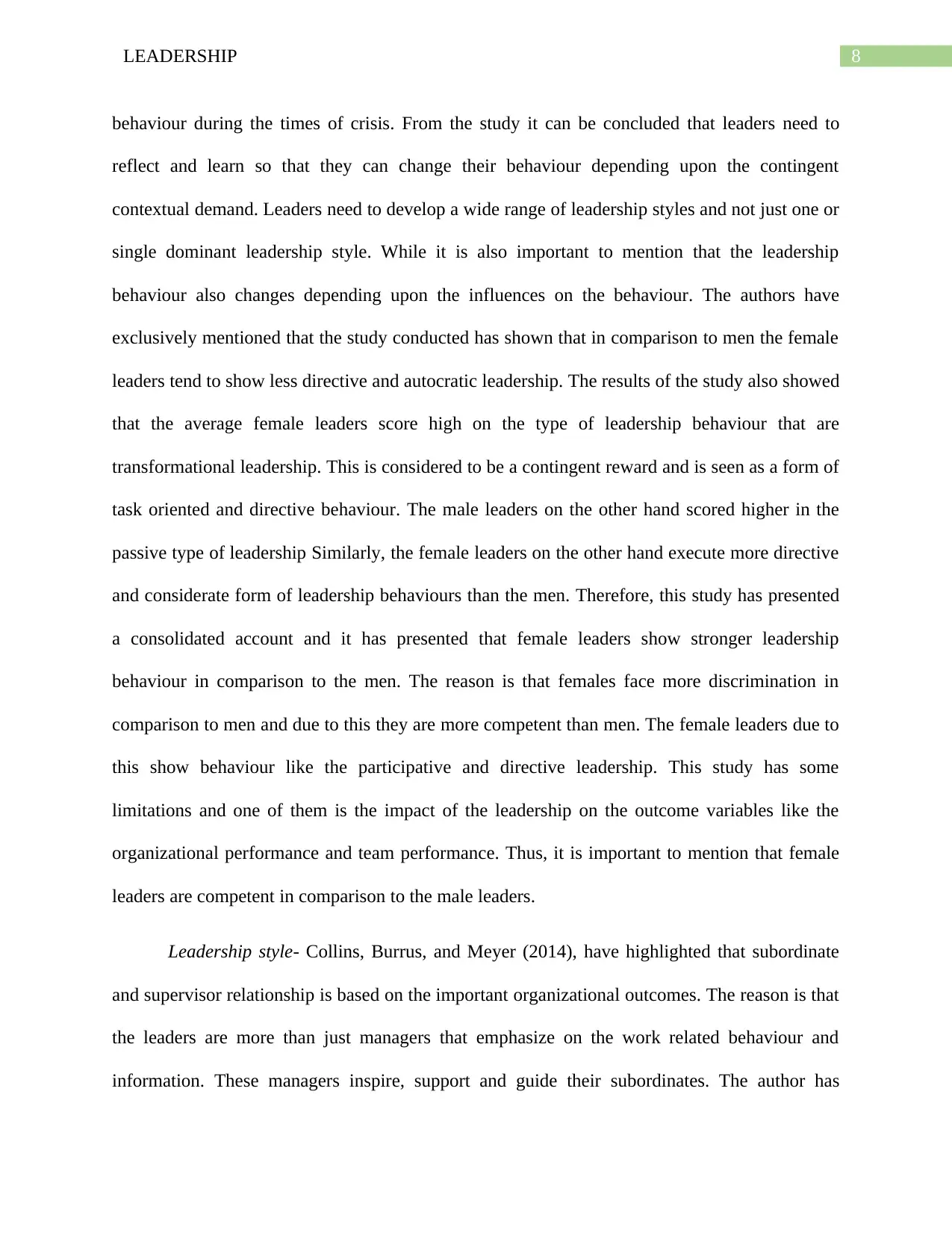
8LEADERSHIP
behaviour during the times of crisis. From the study it can be concluded that leaders need to
reflect and learn so that they can change their behaviour depending upon the contingent
contextual demand. Leaders need to develop a wide range of leadership styles and not just one or
single dominant leadership style. While it is also important to mention that the leadership
behaviour also changes depending upon the influences on the behaviour. The authors have
exclusively mentioned that the study conducted has shown that in comparison to men the female
leaders tend to show less directive and autocratic leadership. The results of the study also showed
that the average female leaders score high on the type of leadership behaviour that are
transformational leadership. This is considered to be a contingent reward and is seen as a form of
task oriented and directive behaviour. The male leaders on the other hand scored higher in the
passive type of leadership Similarly, the female leaders on the other hand execute more directive
and considerate form of leadership behaviours than the men. Therefore, this study has presented
a consolidated account and it has presented that female leaders show stronger leadership
behaviour in comparison to the men. The reason is that females face more discrimination in
comparison to men and due to this they are more competent than men. The female leaders due to
this show behaviour like the participative and directive leadership. This study has some
limitations and one of them is the impact of the leadership on the outcome variables like the
organizational performance and team performance. Thus, it is important to mention that female
leaders are competent in comparison to the male leaders.
Leadership style- Collins, Burrus, and Meyer (2014), have highlighted that subordinate
and supervisor relationship is based on the important organizational outcomes. The reason is that
the leaders are more than just managers that emphasize on the work related behaviour and
information. These managers inspire, support and guide their subordinates. The author has
behaviour during the times of crisis. From the study it can be concluded that leaders need to
reflect and learn so that they can change their behaviour depending upon the contingent
contextual demand. Leaders need to develop a wide range of leadership styles and not just one or
single dominant leadership style. While it is also important to mention that the leadership
behaviour also changes depending upon the influences on the behaviour. The authors have
exclusively mentioned that the study conducted has shown that in comparison to men the female
leaders tend to show less directive and autocratic leadership. The results of the study also showed
that the average female leaders score high on the type of leadership behaviour that are
transformational leadership. This is considered to be a contingent reward and is seen as a form of
task oriented and directive behaviour. The male leaders on the other hand scored higher in the
passive type of leadership Similarly, the female leaders on the other hand execute more directive
and considerate form of leadership behaviours than the men. Therefore, this study has presented
a consolidated account and it has presented that female leaders show stronger leadership
behaviour in comparison to the men. The reason is that females face more discrimination in
comparison to men and due to this they are more competent than men. The female leaders due to
this show behaviour like the participative and directive leadership. This study has some
limitations and one of them is the impact of the leadership on the outcome variables like the
organizational performance and team performance. Thus, it is important to mention that female
leaders are competent in comparison to the male leaders.
Leadership style- Collins, Burrus, and Meyer (2014), have highlighted that subordinate
and supervisor relationship is based on the important organizational outcomes. The reason is that
the leaders are more than just managers that emphasize on the work related behaviour and
information. These managers inspire, support and guide their subordinates. The author has
⊘ This is a preview!⊘
Do you want full access?
Subscribe today to unlock all pages.

Trusted by 1+ million students worldwide

9LEADERSHIP
mentioned that high quality relationships have led to deeper integration within the organization.
extant research conducted by the author have shown that that women and men respond
differently to the different aspects of social relationships and this can be categorized either as
agentic or communal. It is important to mention that the genetic dimension originates
interpersonally and it is concerned with the welfare of others and in thus dimension women is
found to score high than men. While the agentic dimension is found to be task oriented and it can
be described to be having the assertive tendencies, masterful and independent tendencies as well.
Here men scored higher than women in this dimension. The author has failed to provide a clear
account of the differences in the gender as per the leadership styles. The study also has some of
the limitations and this include the participants that were self- selected. While it has been
highlighted by Gardiner (2018), that there is a need to continually trouble the dominant forms of
privilege and the organizational structures. It is important to mention that it is not just hiring
women leaders to solve the gender related issues in workplace if the desired outcome is gender
justice. it has bene seen that one woman is holding accountable another woman to the normative
gendered outcomes. Thus, it is important to highlight that placing women on to a powerful
position will not lead to empowerment of women in a group. This study altogether presented a
different approach towards the feminist phenomenology and organizational framework and has
less of account of leadership that can provide an insight into the leadership type. Inal (2017),
Women's role in political leadership has long been ignored and both in the political scenes and in
the study of political leadership. There has long been a [perception that women are unfit as
leaders. Thus, in Turkish contest it can be seen that the gender itself does not contribute to a
leader in to more democratic and ethical. This study has presented and highlighted a political
leadership. The leadership style is not emphasizing upon totally and the study is more of a
mentioned that high quality relationships have led to deeper integration within the organization.
extant research conducted by the author have shown that that women and men respond
differently to the different aspects of social relationships and this can be categorized either as
agentic or communal. It is important to mention that the genetic dimension originates
interpersonally and it is concerned with the welfare of others and in thus dimension women is
found to score high than men. While the agentic dimension is found to be task oriented and it can
be described to be having the assertive tendencies, masterful and independent tendencies as well.
Here men scored higher than women in this dimension. The author has failed to provide a clear
account of the differences in the gender as per the leadership styles. The study also has some of
the limitations and this include the participants that were self- selected. While it has been
highlighted by Gardiner (2018), that there is a need to continually trouble the dominant forms of
privilege and the organizational structures. It is important to mention that it is not just hiring
women leaders to solve the gender related issues in workplace if the desired outcome is gender
justice. it has bene seen that one woman is holding accountable another woman to the normative
gendered outcomes. Thus, it is important to highlight that placing women on to a powerful
position will not lead to empowerment of women in a group. This study altogether presented a
different approach towards the feminist phenomenology and organizational framework and has
less of account of leadership that can provide an insight into the leadership type. Inal (2017),
Women's role in political leadership has long been ignored and both in the political scenes and in
the study of political leadership. There has long been a [perception that women are unfit as
leaders. Thus, in Turkish contest it can be seen that the gender itself does not contribute to a
leader in to more democratic and ethical. This study has presented and highlighted a political
leadership. The leadership style is not emphasizing upon totally and the study is more of a
Paraphrase This Document
Need a fresh take? Get an instant paraphrase of this document with our AI Paraphraser

10LEADERSHIP
capability of a woman as a leader and the acceptance of women as a leader. Like the rest of the
article the state of women is commented and worked upon the authors.
Leadership model- Behrendt, Matz and Göritz (2017), have highlighted that the
integrative model of the leadership behaviour is based on the psychological theory and it
includes 6 different leadership behaviour. The behaviours include two different aspects like the
relations oriented so that the followers can be influenced, and second is the task oriented so as to
support the accomplishments of the objectives. The task oriented process helps in contributing
the accomplishments of the objectives. While the relations oriented behaviours support the
processes by providing followers resources. One of the positive part of the work is that author
have presented an innovative model of leadership behaviour. The model is framed because there
has bene serious flaws into the leadership behaviours because researches used to neglect the
same. While the integrative model is found to be comprehensive and broad. While it has been
highlighted by Lovelace et al. (2018), that charismatic, ideological and pragmatic model (CIP) of
leadership highlights a unique perspective that provides an effective leadership approach and it is
distinctive as well. The CIP model of leadership has the potential to address several concerns and
it also addresses many concerns that expands the leadership and lays down a strong conceptual
perspective. However, this article provides an overall and sound presentation of the CIP model
and lastly the CIP model is found to be adaptive and largely acceptable among the leaders.
Conclusion- From the above discussion it can be concluded that major types of behaviour
that have predicted the success of the leadership. This includes the transformational leadership,
empowerment, and boundary spanning. Firstly, the transformational leadership can be described
as the conglomerate of the different types of the behaviours that are found in the effective
leaders. The behavioural factors that are noticed in the transformational leaders are the
capability of a woman as a leader and the acceptance of women as a leader. Like the rest of the
article the state of women is commented and worked upon the authors.
Leadership model- Behrendt, Matz and Göritz (2017), have highlighted that the
integrative model of the leadership behaviour is based on the psychological theory and it
includes 6 different leadership behaviour. The behaviours include two different aspects like the
relations oriented so that the followers can be influenced, and second is the task oriented so as to
support the accomplishments of the objectives. The task oriented process helps in contributing
the accomplishments of the objectives. While the relations oriented behaviours support the
processes by providing followers resources. One of the positive part of the work is that author
have presented an innovative model of leadership behaviour. The model is framed because there
has bene serious flaws into the leadership behaviours because researches used to neglect the
same. While the integrative model is found to be comprehensive and broad. While it has been
highlighted by Lovelace et al. (2018), that charismatic, ideological and pragmatic model (CIP) of
leadership highlights a unique perspective that provides an effective leadership approach and it is
distinctive as well. The CIP model of leadership has the potential to address several concerns and
it also addresses many concerns that expands the leadership and lays down a strong conceptual
perspective. However, this article provides an overall and sound presentation of the CIP model
and lastly the CIP model is found to be adaptive and largely acceptable among the leaders.
Conclusion- From the above discussion it can be concluded that major types of behaviour
that have predicted the success of the leadership. This includes the transformational leadership,
empowerment, and boundary spanning. Firstly, the transformational leadership can be described
as the conglomerate of the different types of the behaviours that are found in the effective
leaders. The behavioural factors that are noticed in the transformational leaders are the

11LEADERSHIP
contingent rewards, intellectual simulations, individual consideration and charisma. The
behaviours pertaining to laissez-faire, transactional leadership, and transformational leadership
are perceived to be more of a typical male or female. It has been always seen that the typical
form of leadership is mainly held by men. Due to this the vital traits of leadership is believed to
be of men and there have been a trend like think manager think male. However, it is important to
mention that the concept of leadership has undergone a considerable amount of change and the
new challenges of working require new terms of leadership. the new generations bring with them
new ways of looking towards the issues, new behaviours, and new ideas are most highlighting
features. Due to this there has been persistent research going on how new ways of management
theories can evolve from time to another.
contingent rewards, intellectual simulations, individual consideration and charisma. The
behaviours pertaining to laissez-faire, transactional leadership, and transformational leadership
are perceived to be more of a typical male or female. It has been always seen that the typical
form of leadership is mainly held by men. Due to this the vital traits of leadership is believed to
be of men and there have been a trend like think manager think male. However, it is important to
mention that the concept of leadership has undergone a considerable amount of change and the
new challenges of working require new terms of leadership. the new generations bring with them
new ways of looking towards the issues, new behaviours, and new ideas are most highlighting
features. Due to this there has been persistent research going on how new ways of management
theories can evolve from time to another.
⊘ This is a preview!⊘
Do you want full access?
Subscribe today to unlock all pages.

Trusted by 1+ million students worldwide
1 out of 14
Related Documents
Your All-in-One AI-Powered Toolkit for Academic Success.
+13062052269
info@desklib.com
Available 24*7 on WhatsApp / Email
![[object Object]](/_next/static/media/star-bottom.7253800d.svg)
Unlock your academic potential
Copyright © 2020–2025 A2Z Services. All Rights Reserved. Developed and managed by ZUCOL.





